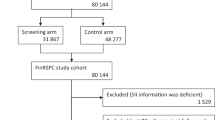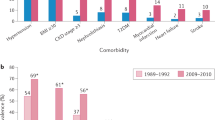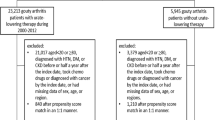Abstract
Background:
Clinical observations indicated an increased risk of developing prostate cancer in gout patients. Chronic inflammation is postulated to be one crucial mechanism for prostate carcinogenesis. Allopurinol, a widely used antigout agent, possesses potent anti-inflammation capacity. We elucidated whether allopurinol decreases the risk of prostate cancer in gout patients.
Methods:
We analyzed data retrieved from Taiwan National Health Insurance Database between January 2000 and December 2012. Patients diagnosed with gout during the study period with no history of prostate cancer and who had never used allopurinol were selected. Four allopurinol use cohorts (that is, allopurinol use (>365 days), allopurinol use (181–365 days), allopurinol use (91–180 days) and allopurinol use (31–90 days)) and one cohort without using allopurinol (that is, allopurinol use (No)) were included. The study end point was the diagnosis of new-onset prostate cancer. Multivariable Cox proportional hazards regression and propensity score-adjusted Cox regression models were used to estimate the association between the risk of prostate cancer and allopurinol treatment in gout patients after adjusting for potential confounders.
Results:
A total of 25 770 gout patients (aged between 40 and 100 years) were included. Multivariable Cox regression analyses revealed that the risk of developing prostate cancer in the allopurinol use (>365 days) cohort was significantly lower than the allopurinol use (No) cohort (adjusted hazard ratio (HR)=0.64, 95% confidence interval (CI)=0.45–0.9, P=0.011). After propensity score adjustment, the trend remained the same (adjusted HR=0.66, 95% CI=0.46–0.93, P=0.019).
Conclusions:
Long-term (more than 1 year) allopurinol use may associate with a decreased risk of prostate cancer in gout patients.
This is a preview of subscription content, access via your institution
Access options
Subscribe to this journal
Receive 4 print issues and online access
$259.00 per year
only $64.75 per issue
Buy this article
- Purchase on Springer Link
- Instant access to full article PDF
Prices may be subject to local taxes which are calculated during checkout

Similar content being viewed by others
References
Bardin T, Richette P . Definition of hyperuricemia and gouty conditions. Curr Opin Rheumatol 2014; 26: 186–191.
Singh JA . Gout: will the "King of Diseases" be the first rheumatic disease to be cured? BMC Med 2016; 14: 180.
Kienhorst LB, van Lochem E, Kievit W, Dalbeth N, Merriman ME, Phipps-Green A et al. Gout is a chronic inflammatory disease in which high levels of interleukin-8 (CXCL8), myeloid-related protein 8/myeloid-related protein 14 complex, and an altered proteome are associated with diabetes mellitus and cardiovascular disease. Arthritis Rheumatol 2015; 67: 3303–3313.
Wang W, Xu D, Wang B, Yan S, Wang X, Yin Y et al. Increased risk of cancer in relation to gout: a review of three prospective cohort studies with 50,358 subjects. Mediators Inflamm 2015; 2015: 680853.
Chen CJ, Yen JH, Chang SJ . Gout patients have an increased risk of developing most cancers, especially urological cancers. Scand J Rheumatol 2014; 43: 385–390.
Kuo CF, Luo SF, See LC, Chou IJ, Fang YF, Yu KH . Increased risk of cancer among gout patients: a nationwide population study. Joint Bone Spine 2012; 79: 375–378.
Boffetta P, Nordenvall C, Nyren O, Ye W . A prospective study of gout and cancer. Eur J Cancer Prev 2009; 18: 127–132.
Pacher P, Nivorozhkin A, Szabo C . Therapeutic effects of xanthine oxidase inhibitors: renaissance half a century after the discovery of allopurinol. Pharmacol Rev 2006; 58: 87–114.
Park JJ, Roudier MP, Soman D, Mokadam NA, Simkin PA . Prevalence of birefringent crystals in cardiac and prostatic tissues, an observational study. BMJ Open 2014; 4: e005308.
De Marzo AM, Platz EA, Sutcliffe S, Xu J, Gronberg H, Drake CG et al. Inflammation in prostate carcinogenesis. Nat Rev Cancer 2007; 7: 256–269.
Yasuda T, Yoshida T, Goda AE, Horinaka M, Yano K, Shiraishi T et al. Anti-gout agent allopurinol exerts cytotoxicity to human hormone-refractory prostate cancer cells in combination with tumor necrosis factor-related apoptosis-inducing ligand. Mol Cancer Res 2008; 6: 1852–1860.
Kimura T . East meets West: ethnic differences in prostate cancer epidemiology between East Asians and Caucasians. Chin J Cancer 2012; 31: 421–429.
Hung CF, Yang CK, Ou YC . Urologic cancer in Taiwan. Jpn J Clin Oncol 2016; 46: 605–609.
Sun LM, Lin MC, Lin CL, Chang SN, Liang JA, Lin IC et al. Statin use reduces prostate cancer all-cause mortality: a nationwide population-based cohort study. Medicine (Baltimore) 2015; 94: e1644.
Cheng CL, Kao YH, Lin SJ, Lee CH, Lai ML . Validation of the National Health Insurance Research Database with ischemic stroke cases in Taiwan. Pharmacoepidemiol Drug Saf 2011; 20: 236–242.
Wallace SL, Robinson H, Masi AT, Decker JL, McCarty DJ, Yu TF . Preliminary criteria for the classification of the acute arthritis of primary gout. Arthritis Rheum 1977; 20: 895–900.
Yu TM, Chuang YW, Yu MC, Chen CH, Yang CK, Huang ST et al. Risk of cancer in patients with polycystic kidney disease: a propensity-score matched analysis of a nationwide, population-based cohort study. Lancet Oncol 2016; 17: 1419–1425.
Ozbek E, Otunctemur A, Dursun M, Sahin S, Besiroglu H, Koklu I et al. Diabetes mellitus and HbA1c levels associated with high grade prostate cancer. Asian Pac J Cancer Prev 2014; 15: 2555–2558.
Banez LL, Loftis RM, Freedland SJ, Presti JC Jr, Aronson WJ, Amling CL et al. The influence of hepatic function on prostate cancer outcomes after radical prostatectomy. Prostate Cancer Prostatic Dis 2010; 13: 173–177.
Liang Z, Xie B, Li J, Wang X, Wang S, Meng S et al. Hypertension and risk of prostate cancer: a systematic review and meta-analysis. Sci Rep 2016; 6: 31358.
Hayashi N, Matsushima M, Yamamoto T, Sasaki H, Takahashi H, Egawa S . The impact of hypertriglyceridemia on prostate cancer development in patients aged >/=60 years. BJU Int 2012; 109: 515–519.
Solomon KR, Freeman MR . The complex interplay between cholesterol and prostate malignancy. Urol Clin North Am 2011; 38: 243–259.
Thakur H, Gupta L, Sobti RC, Janmeja AK, Seth A, Singh SK . Association of GSTM1T1 genes with COPD and prostate cancer in north Indian population. Mol Biol Rep 2011; 38: 1733–1739.
Vidal AC, Freedland SJ . Obesity and prostate cancer: a focused update on active surveillance, race, and molecular subtyping. Eur Urol 2016 (e-pub ahead of print 10 October 2016; doi:10.1016/j.eururo.2016.10.011).
Hamilton Z, Parsons JK . Prostate cancer prevention: concepts and clinical trials. Curr Urol Rep 2016; 17: 35.
Huang TB, Yan Y, Guo ZF, Zhang XL, Liu H, Geng J et al. Aspirin use and the risk of prostate cancer: a meta-analysis of 24 epidemiologic studies. Int Urol Nephrol 2014; 46: 1715–1728.
Sangkop F, Singh G, Rodrigues E, Gold E, Bahn A . Uric acid: a modulator of prostate cells and activin sensitivity. Mol Cell Biochem 2016; 414: 187–199.
Kuo CF, Grainge MJ, See LC, Yu KH, Luo SF, Zhang W et al. Epidemiology and management of gout in Taiwan: a nationwide population study. Arthritis Res Ther 2015; 17: 13.
Kuo CF, Grainge MJ, Zhang W, Doherty M . Global epidemiology of gout: prevalence, incidence and risk factors. Nat Rev Rheumatol 2015; 11: 649–662.
Mikuls TR, Farrar JT, Bilker WB, Fernandes S, Schumacher HR Jr, Saag KG . Gout epidemiology: results from the UK General Practice Research Database, 1990-1999. Ann Rheum Dis 2005; 64: 267–272.
Kuo CF, Grainge MJ, Mallen C, Zhang W, Doherty M . Rising burden of gout in the UK but continuing suboptimal management: a nationwide population study. Ann Rheum Dis 2015; 74: 661–667.
Battelli MG, Polito L, Bortolotti M, Bolognesi A . Xanthine oxidoreductase in cancer: more than a differentiation marker. Cancer Med 2016; 5: 546–557.
Zhang Y, Neogi T, Chen C, Chaisson C, Hunter DJ, Choi H . Low-dose aspirin use and recurrent gout attacks. Ann Rheum Dis 2014; 73: 385–390.
Author information
Authors and Affiliations
Corresponding author
Ethics declarations
Competing interests
The authors declare no conflict of interest.
Rights and permissions
About this article
Cite this article
Shih, HJ., Kao, MC., Tsai, PS. et al. Long-term allopurinol use decreases the risk of prostate cancer in patients with gout: a population-based study. Prostate Cancer Prostatic Dis 20, 328–333 (2017). https://doi.org/10.1038/pcan.2017.14
Received:
Revised:
Accepted:
Published:
Issue Date:
DOI: https://doi.org/10.1038/pcan.2017.14
This article is cited by
-
Allopurinol and prostate cancer survival in a Finnish population-based cohort
Prostate Cancer and Prostatic Diseases (2024)
-
The double faced role of xanthine oxidoreductase in cancer
Acta Pharmacologica Sinica (2022)
-
Retrospective evaluation of the impact of non-oncologic chronic drug therapy on the survival in patients with bladder cancer
International Journal of Clinical Pharmacy (2022)
-
Allopurinol and the risk of prostate cancer in a Finnish population-based cohort
Prostate Cancer and Prostatic Diseases (2019)



